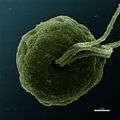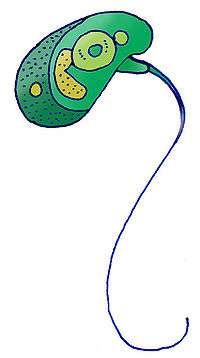Prasinophyceae
| Prasinophyceae | |
|---|---|
| Scientific classification | |
| Domain: | Eukaryota |
| Kingdom: | Viridiplantae |
| Division: | Chlorophyta |
| Class: | Prasinophyceae T.Christensen ex P.C.Silva 1980 |
| Orders[1] | |
| |
The Prasinophytes are a paraphyletic class of unicellular green algae in the Division Chlorophyta.[2] Prasinophytes mainly include marine planktonic species, as well as some freshwater representatives.[2][3] The prasinophytes are morphologically diverse, including flagellates with one to eight flagella and non-motile (coccoid) unicells. The cells of many species are covered with organic body scales; others are naked.[3] One well known genus is Ostreococcus, considered to be the smallest (ca. 0.95 μm) free-living eukaryote,[4] found in marine waters worldwide. Prasinophytes have simple cellular structures, containing a single chloroplast and a single mitochondrion. The genomes are relatively small compared to other eukaryotes (about 12 Mbp for Ostreococcus[5][6] and 21 Mbp for Micromonas[7]).
Recent studies agree that the prasinophytes are a non-evolutionary grouping (paraphyletic) of chlorophyte green algae from different clades. Alternative classifications of the chlorophytes have been proposed in which this class is replaced by at least six separate taxa.[8]
Ecology

A study of photosynthetic gene-sequence diversity (rbcL) in the Gulf of Mexico indicated that Prasinophytes are particularly prevalent at the Subsurface Chlorophyll Maximum (SCM)[9] and several different ecotypes of Ostreococcus have been detected in the environment.[10] These ecotypes were thought to be distinguished in the environment by their adaptation to light intensities. O. lucimarinus was isolated from a high-light environment[11] and observed year-round in the coastal North Pacific Ocean.[12] RCC141 was considered low-light, because it was isolated from the lower euphotic zone. These strains, or ecotypes, were later shown to live in different habitats (open-ocean or mesotrophic) and their distributions do not appear to be connected to light availability.[13] O. tauri was isolated from a coastal lagoon and appears to be light-polyvalent. Genetic data indicates that distinct molecular differences exist between the different ecotypes that have been detected.[14]
Phylogeny
Recent studies agree that the prasinophytes are not a natural group, being highly paraphyletic.[3][8][15][16] Relationships among the groups making up the Chlorophyta are not fully resolved. The cladogram produced by Leliaert et al. 2011[3] is shown below. The blue shaded groups are or have traditionally been placed in the Prasinophyceae[2]). The species Mesostigma viride has been shown to be a member of the Streptophyta rather than the Chlorophyta.
| |
| ||||||||||||||||||||||||||||||||||||||||||||||||||||||||||||||||||||||||||||||||||||||||||||||||||||||||||||
| |
References
- ↑ Guiry, M.D. & Guiry, G.M. (2007). "Class: Prasinophyceae taxonomy browser". AlgaeBase version 4.2 Worldwide electronic publication, National University of Ireland, Galway. Retrieved 2007-09-23.
- 1 2 3 Sym, S. D. and Pienaar, R. N. 1993. The class Prasinophyceae. In Round, F. E. and Chapman, D. J. (eds) Progress in Phycological Research, Vol. 9. Biopress Ltd., Bristol, pp. 281-376.
- 1 2 3 4 Leliaert, Frederik; Verbruggen, Heroen; Zechman, Frederick W. (2011). "Into the deep: New discoveries at the base of the green plant phylogeny". BioEssays. 33 (9): 683–692. doi:10.1002/bies.201100035. ISSN 0265-9247. PMID 21744372.
- ↑ Courties C, Vaquer A, Troussellier M, Lautier J, Chrétiennot-Dinet MJ, Neveux J, Machado C, Claustre H (1994). "Smallest eukaryotic organism". Nature. 370 (6487): 255. doi:10.1038/370255a0.
- ↑ Derelle E, et al. (2006). "Genome analysis of the smallest free-living eukaryote Ostreococcus tauri unveils many unique features". PNAS. 103 (31): 11647–52. doi:10.1073/pnas.0604795103. PMC 1544224
 . PMID 16868079.
. PMID 16868079. - ↑ Palenik, Brian; et al. (2007). "The tiny eukaryote Ostreococcus provides genomic insights into the paradox of plankton speciation". PNAS. 104 (18): 7705–7710. doi:10.1073/pnas.0611046104. PMC 1863510
 . PMID 17460045.
. PMID 17460045. - ↑ Worden AZ, et al. (2009). "Green evolution and dynamic adaptations revealed by genomes of the marine picoeukaryotes Micromonas". Science. 324 (5924): 268–272. doi:10.1126/science.1167222. PMID 19359590.
- 1 2 Lewis, Louise A. & McCourt, R.M. (2004). "Green algae and the origin of land plants". Am. J. Bot. 91 (10): 1535–1556. doi:10.3732/ajb.91.10.1535. PMID 21652308.
- ↑ Wawrik B, Paul JH, Campbell L, Griffin D, Houchin L, Fuentes-Ortega A, Müller-Karger F (2003). "Vertical Structure of the Phytoplankton Community Associated with a Coastal Plume in the Gulf of Mexico". Marine Ecology Progress Series. 251: 87–101. doi:10.3354/meps251087.
- ↑ Guillou L, Eikrem W, Chrétiennot-Dinnet MJ, Le Gall F, Massana R, Romari K, Pedros-Alio C, Vaulot D (2004). "Diversity of picoplanktonic Prasinophyceae assessed by direct SSU rDNA sequencing of environmental samples and novel isolates retrieved from oceanic and coastal marine ecosystems". Protist. 155 (2): 193–214. doi:10.1078/143446104774199592. PMID 15305796.
- ↑ Worden AZ, Nolan JK, Palenik B (2004). "Assessing the dynamics and ecology of marine picophytoplankton: The importance of the eukaryotic component". Limnology and Oceanography. 49 (1): 168–179. doi:10.4319/lo.2004.49.1.0168.
- ↑ Worden AZ (2006). "Picoeukaryote diversity in coastal waters of the Pacific Ocean". Aquatic Microbial Ecology. 43 (2): 165–175. doi:10.3354/ame043165.
- ↑ Demir-Hilton E, Sudek S, Cuvelier ML, Gentemann CL, Zehr JP, Worden AZ (2011). "Global distribution patterns of distinct clades of the photosynthetic picoeukaryote Ostreococcus". ISME Journal. 5 (7): 1095–1107. doi:10.1038/ismej.2010.209. PMC 3146286
 . PMID 21289652.
. PMID 21289652. - ↑ Rodríguez F, Derelle E, Guillou L, Le Gall F, Vaulot D, Moreau H (2005). "Ecotype diversity in the marine picoeukaryote Ostreococcus (Chlorophyta, Prasinophyceae)". Environmental Microbiology. 7 (6): 853–859. doi:10.1111/j.1462-2920.2005.00758.x. PMID 15892704.
- ↑ Becker, B. & Marin, B. (2009). "Streptophyte algae and the origin of embryophytes". Annals of Botany. 103 (7): 999–1004. doi:10.1093/aob/mcp044. PMC 2707909
 . PMID 19273476.
. PMID 19273476. - ↑ Marin, Birger (2012). "Nested in the Chlorellales or Independent Class? Phylogeny and Classification of the Pedinophyceae (Viridiplantae) Revealed by Molecular Phylogenetic Analyses of Complete Nuclear and Plastid-encoded rRNA Operons". Protist. 163: 778–805. doi:10.1016/j.protis.2011.11.004.
External links
| Wikispecies has information related to: Prasinophyceae |
| Wikimedia Commons has media related to Prasinophyceae. |
Links to scientific references
- PubMed references for Prasinophyceae
- PubMed Central references for Prasinophyceae
- Google Scholar references for Prasinophyceae
Links to scientific databases
- NCBI taxonomy page for Prasinophyceae
- Search Tree of Life taxonomy pages for Prasinophyceae
- Search Species2000 page for Prasinophyceae
- AlgaTerra database
- Index Nominum Genericorum

